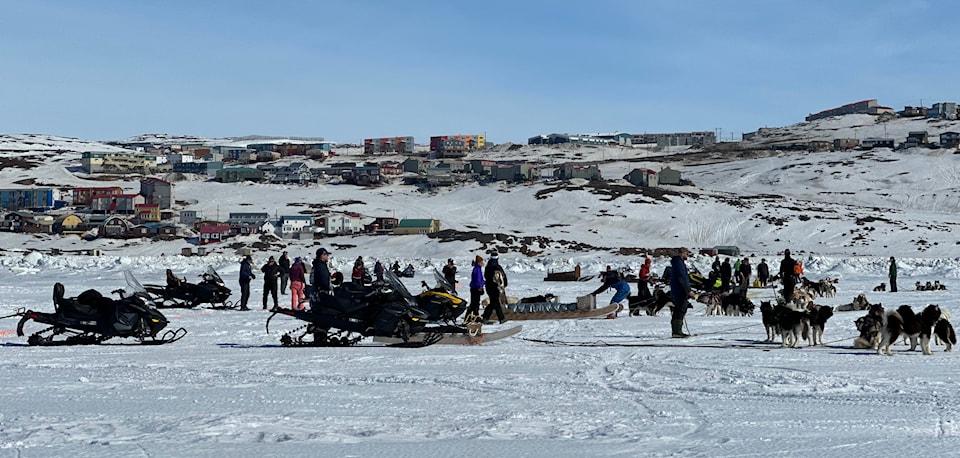Nunavut's population reached 40,721 as of the first quarter of 2024, according to Statistics Canada.
That was only 200 more people, or a 0.5 per cent increase, than during the first quarter of 2023.
While it was just one quarter, it was well below the 2.5 per cent population growth rate that Nunavut experienced from 2016 to 2021, Statistics Canada data show.
During the 2023 calendar year, there were 711 births and 214 deaths, for a population increase of 497.
The number of people from within Canada who moved to Nunavut in 2023 amounted to 1,519 but that was overshadowed by the 1,944 who left the territory.
There was a net gain of 71 immigrants who were non-permanent residents.
Of the 40,673 Nunavut residents on the record as of July 1, 2023, men outnumbered women 20,576 to 20,097.
Much younger population
The median age of Nunavummiut as of July 1, 2023, was 26.7 years, by far the youngest in the country. The national median age at that time was 40.6.
The Government of Canada projects that it will make $53,295 in per capita allocation payments to the Government of Nunavut in 2024-25, up from $50,066 in transfers per person in 2023-24.
Some communities grow, some shrink
Across the territory, 15 communities grew in population between July 1, 2022 and July 1, 2023 population estimates by Statistics Canada while 10 were in decline.
Experiencing the largest growth was Rankin Inlet, which added an estimated 92 citizens. Arviat also saw its numbers swell with another 49 people added while elsewhere in the Kivalliq, Baker Lake fell by approximately 33 people.
In the Qikiqtaaluk, Iqaluit was bolstered by another 60 residents while Iglulik jumped by 47, Arctic Bay by 39 and Pond Inlet by 32. Kinngait realized the biggest loss with an estimated 88 fewer residents while Sanikiluaq declined by approximately 36 citizens.
Kitikmeot communities saw lesser changes in terms of real numbers, with Cambridge Bay growing by 22 people while Gjoa Haven had 24 fewer residents year over year.
Percentage of Inuit residents rises
Based on the 2021 census, which uses a different approach to ascertaining population than Statistics Canada's quarterly estimates, Iqaluit's population declined four per cent to 7,429 from the 7,740 estimated during the 2016 census.
The number of residents in the capital city who identified as Inuit was 3,830 while 3,255 were listed as having non-Indigenous identity.
There were 3,297 private dwellings in Iqaluit as of 2021, of which 2,710 were occupied. The average occupancy per residence was 2.7 people, according to the census.
As a whole, the territory had 11,720 private dwellings.
Statistics Canada's estimate of the Inuit population, based on the 2021 census, was 30,860, up 2.4 per cent from the last census. That data was released in April. Across the country, there were 70,545 people who identified as Inuit.
Fact file
Population estimates by region and community as of July 1, 2023
Qikiqtaaluk region: 21,384 (21,313 in 2022)
Iqaluit 8,296 (8,236 in 2022)
Iglulik 2,279 (2,232 in 2022)
Pond Inlet 1,758 (1,726 in 2022)
Kinngait 1,466 (1,554 in 2022)
Pangnirtung 1,673 (1,636 in 2022)
Clyde River 1,278 (1,286 in 2022)
Sanikiluaq 1,058 (1,094 in 2022)
Sanirajak 982 (993 in 2022)
Arctic Bay 1,106 (1,067 in 2022)
Qikiqtarjuaq 652 (658 in 2022)
Kimmirut 474 (471 in 2022)
Resolute 202 (201 in 2022)
Grise Fiord 160 (159 in 2022)
Kivalliq region: 12,199 (12,085 in 2022)
Rankin Inlet 3,379 (3,287 in 2022)
Arviat 3,170 (3,121 in 2022)
Baker Lake 2,192 (2,225 in 2022)
Naujaat 1,349 (1,336 in 2022)
Coral Harbour 1,128 (1,135 in 2022)
Whale Cove 528 (523 in 2022)
Chesterfield Inlet 433 (438 in 2022)
Kitikmeot region: 7,090 (7,087 in 2022)
Cambridge Bay 1,952 (1,930 in 2022)
Kugluktuk 1,501 (1,517 in 2022)
Gjoa Haven 1,435 (1,459 in 2022)
Taloyoak 1,024 (1,026 in 2022)
Kugaaruk 1,178 (1,155 in 2022)
Source: Statistics Canada


.png;w=120;h=80;mode=crop)
